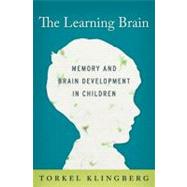
| Preface | p. vii |
| Acknowledgments | p. xiii |
| Being Unlucky When You Think: The Importance of Working Memory | p. 1 |
| Remembering What to Concentrate on | p. 2 |
| Why Do Students Daydream? | p. 3 |
| The Working Memories of the Nynäshamn Children | p. 5 |
| Attention-Deficit/Hyperactivity Disorder and Children with Low Working Memories | p. 8 |
| The Growing Brain: How the Brain Develops and Matures | p. 13 |
| The Development of the Brain | p. 15 |
| The Brain Matures | p. 17 |
| Genes and the Brain | p. 20 |
| The White Matter | p. 22 |
| Through the Pyrenees by Motorbike: The Risk-Taking Teenage Brain | p. 25 |
| Risks and Rewards | p. 26 |
| Neuroscience and the Law | p. 29 |
| Now I Am Really Awake for the First Time Ever: Long-Term Memory | p. 33 |
| Children's Long-Term Memory | p. 34 |
| The Key to the Memory | p. 36 |
| Improving the Long-Term Memory | p. 43 |
| Mathematics, Memory, and Space | p. 49 |
| Counting Babies | p. 53 |
| Retaining Numbers in Working Memory | p. 56 |
| The Mnemonic Map | p. 58 |
| Mathematical Areas | p. 61 |
| Mathematics and Gender | p. 63 |
| Dyscalculia-Does It Exist? | p. 65 |
| Premature Birth and Dyscalculia | p. 68 |
| Training Programs | p. 70 |
| Reading, Dyslexia, and Problematic Relationships | p. 73 |
| Learning to Read | p. 74 |
| Reading Areas of the Brain and Dyslexia | p. 76 |
| Dyslexia: Genetics and Displaced Cells | p. 78 |
| Why the Problems Are Interconnected | p. 80 |
| Dyslexia Training and Neuroscientific Predictions | p. 83 |
| The Early Environment and Brain Development: The Importance of Stimulation and Engaged Parents | p. 87 |
| Stimulating Environments and Brain Development | p. 91 |
| The Role of Parents in Memory and Stress | p. 94 |
| Skydiving and Expectations: What Acute and Chronic Stress Do to Us | p. 99 |
| Stress Hormones and Nerve Cells | p. 101 |
| Social Stress | p. 103 |
| Chronic Stress | p. 106 |
| Cognitive Training, Memory Techniques, and Music | p. 111 |
| The Dream of the Perfect Memory | p. 112 |
| The Brain of a Memory Champion | p. 114 |
| Working Memory Training | p. 116 |
| The Art of Training | p. 120 |
| Can Everything Be Trained? | p. 124 |
| Music | p. 126 |
| Body and Soul | p. 131 |
| Jogging and the Brain | p. 132 |
| Intelligence and Infections | p. 137 |
| This Will Change Everything | p. 141 |
| Five Themes | p. 142 |
| A Schoolgirl of the Future | p. 145 |
| Notes | p. 149 |
| Bibliography | p. 161 |
| Index | p. 173 |
| Table of Contents provided by Ingram. All Rights Reserved. |
The New copy of this book will include any supplemental materials advertised. Please check the title of the book to determine if it should include any access cards, study guides, lab manuals, CDs, etc.
The Used, Rental and eBook copies of this book are not guaranteed to include any supplemental materials. Typically, only the book itself is included. This is true even if the title states it includes any access cards, study guides, lab manuals, CDs, etc.